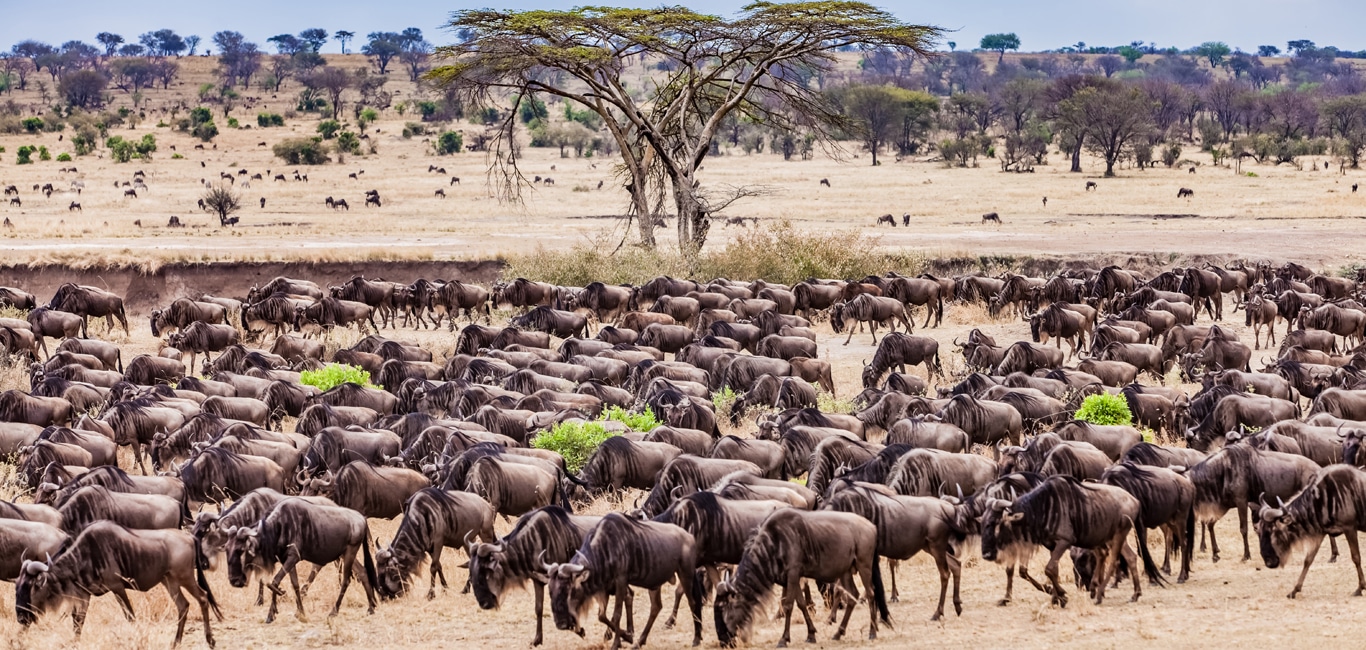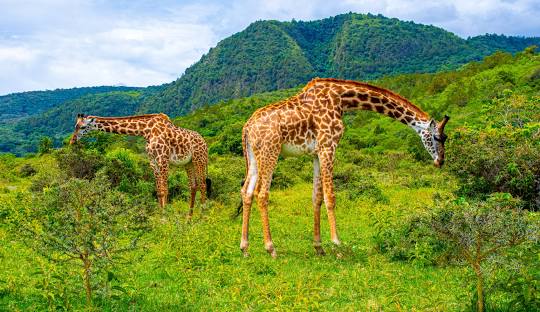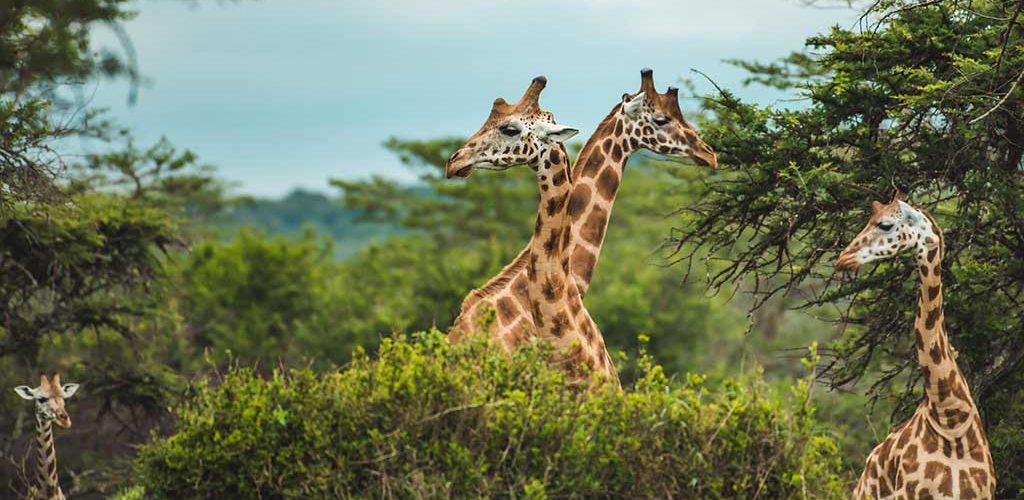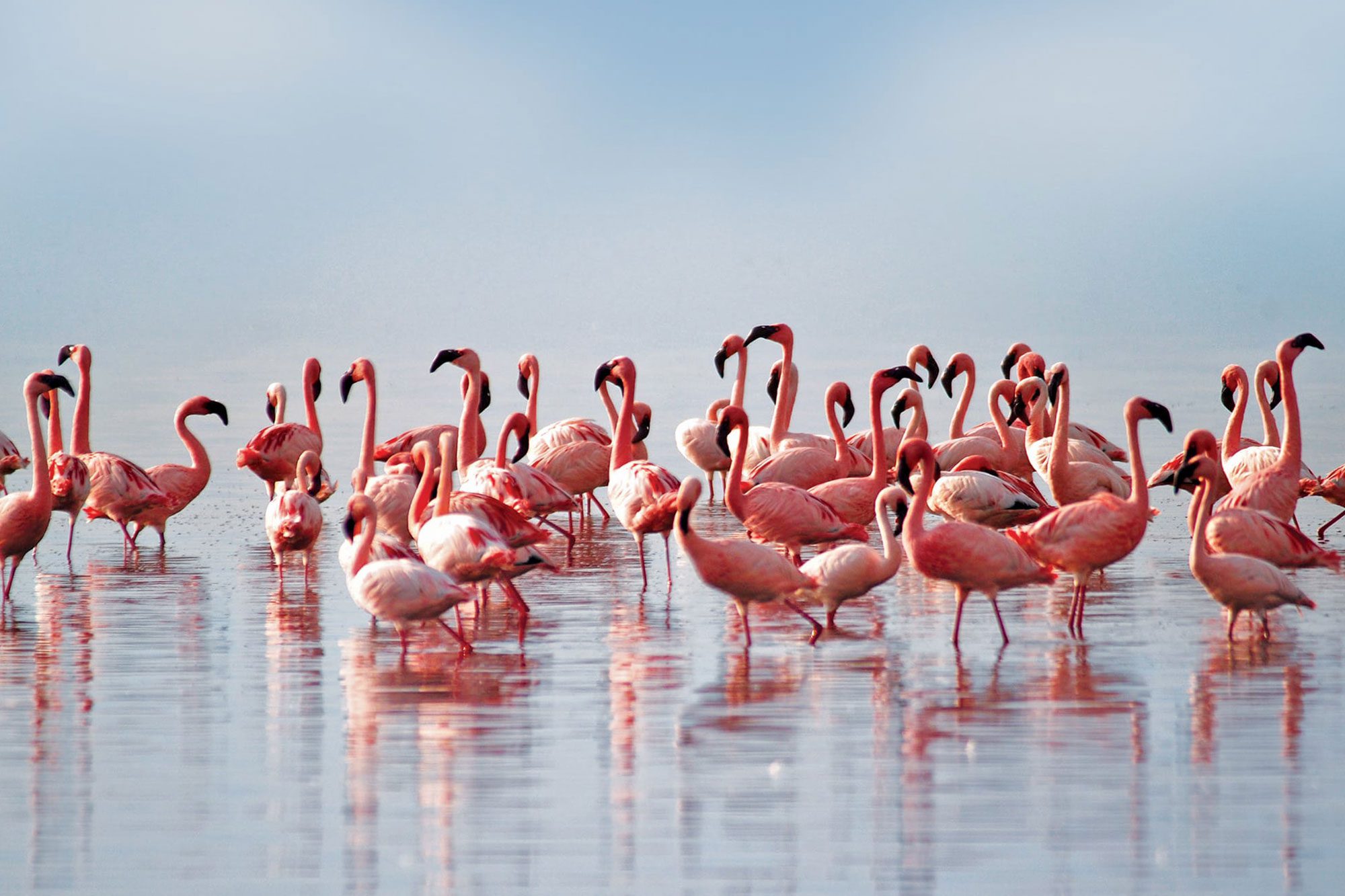Explore The Pearl of Africa Splendid scenery, smiley local people, incredible gorilla treks and remote…

National parks and Reserves in Tanzania
National parks and Reserves in Tanzania
National parks and Reserves in Tanzania take almost a third of the country total land Area ranging from the open savannah areas, Mountains, Forests to lakes. The Tanzania National Park Authority and the community manage the protected areas of Tanzania; the protected areas include the following: Game Reserves, Forest Reserves, Marine parks and National parks.
National parks and conservation Areas in Tanzania inhabit high concentrations of animals, birds, insects, shrubs and other historical sites and museums.
Tanzania has 16 national parks and 3 Game reserves located across the republic of Tanzania, dotted in the South, West and Northern part of Tanzania, hence making all the attractions balanced in the country. Tanzania has been voted several times as the best tourism destination not only in Africa but also in the globe at large and this has been successful due to the hard work by the local community and the Tanzania National Park Authority, who have fought other illegal killings of animals in the park, allowing the local communities to be part of the parks and conservation for instance in the Ngorongoro Conservation Area, animals live together with humans peacefully.
Below are the lists of the National parks and conservation Areas in Tanzania
Arusha National park
Tanzania Arusha city is one of the few cities in Africa that has the national park in the heart of the city. Arusha national park was established in 1960, covering only an area of 137 square kilometers, making it one of the smallest parks in Tanzania. Arusha national park is located in Arusha region, just 25 kilometres away from the main town Arusha, 58 from Moshi and 35 from the main international Airport Kilimanjaro

Arusha national park has the greatest variety of wildlife, as favored by the different ecosystems of the park, ranging from the second-highest mountain, which is Meru, to the low-land swampy areas of the park. Despite its size, a reasonable number of animals like Giraffes, buffalo, warthogs, Zebras, Elephants and different types pf Monkeys for instance the black and white Colobus monkey, Blue monkey and others. Big cats are also present, though they are rarely seen, making locals always term it luck if one sees the big cats.
The dense forest at the park home to many bird species, especially the rare species like Narina trogon and other wood and swamp bird species
Gombe Stream National park
The home for Chimpanzees are other primates, located in the remote Western side of Tanzania in the Kigoma region, just a few kilometers away from Kigoma town, is the smallest national park of Tanzania, covering only an area of 35 square kilometers at the shores of Lake Tanganyika.
Gombe Stream was established in 1968, the park is one of the first African parks where chimpanzee habituation was done credit goes to Goodall, who pioneered all the chimpanzee research in Gombe stream national park. Goodall made documentaries about chimpanzees in different books; the park can only be accessed by boat, making it one of the most expensive parks in Tanzania.
Gombe stream has other animals apart from Chimpanzees like Olive baboons, Red tailed monkeys, blue monkeys, black-faced monkeys and other primates, it’s also a home of leopards, Hippos, buffaloes, bush pigs, snakes and over 200 bird species.
Katavi National Park
Katavi national park was gazetted in 1974 and is located in the Katavi region of Tanzania with a total of 4,471 square kilometers, making it one of the largest national park in Tanzania after Serengeti and Ruaha National Park with Katuma River, Lake Chada and seasonal lake Katavi, it’s the least visited parks in Tanzania with less than 2,000 visitors a year
Katavi national park habits a lot of wildlife, from the big, large herds of animals to the rare bird species, the most popular animals include buffaloes, Wildebeest, Giraffes, Elephants, Zebras, Crocodiles, Hippos, big cats are also easily seen especially lions, Cheetahs and leopards, while other predators are Hyenas, wild dogs.
Lake Manyara National Park
Lake Manyara National Park is located inNorthern Tanzania; it’s one of the parks that form the Northern tourism center of Tanzania alongside Ngorongoro, Serengeti and Tarangire national parks. Northern sector is the most popular tourism sector in Tanzania, hosting over three-quarters of the total tourists that visit Tanzania.
Lake Manyara National Park was established in 1960 with a total area of 330 square kilometers, though almost 200 square kilometers is occupied by Lake Manyara, the soda lake located inside the park. The park is more famous for its tree-climbing lions, which can be easily seen swimming on the branches of the trees, leopards and baboons. Lake Manyara is inhabited by a lot of wildlife like giraffes, buffaloes, Elephants, antelopes, hippos and others, and over 400 bird species, with Flamingos covering most of the lakeside. Other activities in the park are the boat ride at the lake, though it’s seasonal, Hot springs and tree walk.
The park is located in the Northern part of Arusha, reachable within a 2-hour drive along the good, smooth tarmac road passing through the local Maasai villages; it is 126 kilometers away from Arusha, passing through Babati town, the capital of the Manyara region. Lake Manyara has an airfield called lake Manyara airfield located at the top of the enormous rift valley wall.
Mahale Mountains National Park
Located on the shores of Lake Tanganyika, it’s a neighboring park to Gombe stream National park, its found in the Kigoma Region, named after the mountains of Mahale found on its border. Mahale is one of the only two national parks in Tanzania where one can see the Chimpanzees. It has a great record on the number of chimpanzee populations in Tanzania.
Mahale Mountains national park is the only park in Tanzania where one can see lions and chimpanzees in the same park, the funny part of this park is that there is no developed infrastructure like Lodges or a road network within the park, hence making the park hard to access unless one uses a boat.
Kilimanjaro National Park
Kilimanjaro national park also called Mount Kilimanjaro national park is located in the Southern part of Arusha in between Arusha and Moshi towns, just a few kilometers away from Kilimanjaro international airport. The park was established in 1910 and gazetted in 1973 and recognised and listed as Heritage site in 1987
Kilimanjaro national park cover an area of 753 square kilometers. Mount Kilimanjaro is the highest free-standing mountain not only in Tanzania but in the whole world, first designated as a forest reserve in 1921 by the colonial Government before it was officially classified as a national park. The park is unique with a variety of fauna and flora in the park located in different altitudes of the park as you go higher and higher. The bottom forested areas are occupied by animals like Forest Elephants, Bushbucks, Red Duiker, Buffalos, blue monkeys, black and white colobus, leopards and bush babies. The Kilimanjaro national park can be accessed via six routes: the Machame Route, the Marangu Route, the Umbwe Route, the Rongai Route, the Lemosho Route and the Shira Route.

Mikumi National Park
This is the pride of Southern Tanzania located in Morogoro region In Tanzania, Mikumi sits in an area of 3,230 square kilometers, making it the fourth largest national park in Tanzania. Mikumi borders the largest game reserve not only in Tanzania but in Africa, The Uluguru Mountains and Udzungwa Mountains
The park is often referred to as the second Serengeti because of its diverse population of animals, along with scattered Acacia trees, Baobab trees, and other vegetation. Mikumi is inhabited by a wide range of animals in large numbers like wildebeest, zebras, buffaloes, lions, elephants, Impalas, Giraffes and many more, and primates like Yellow baboons, monkeys mention but a few.
The Makta Floodplains are worth visiting due to their great diversity and concentration of wildlife, which graze in a mixed-up format, which is different animals grazing together at the same time, which is not alwayscommon in different parks. Mikumi national park is best visited during the dry season for great enjoyment and clear views of animals.
Tarangire National Park
Tarangire national park was established in 1970, located in the greater Serengeti national park region in Northern Tanzania is one of the best national parks to visit with large herds of animals, especially the Elephants. Tarangire is the 6th largest park in Tanzania, covering an area of 2,850 square kilometers.
The park is easily accessible through the tarmac road from Arusha; it is only a two-hour drive through Karatu town and Babati before you turn to the bumpy local road passing through the maasai villages. The park attains its name from the Tarangire river which runs across the park and acts as a primary water source for wildlife, especially during the dry season when water is scarce.
The Tarangire national park is very famous for its overwhelming population of Elephants and the Baobab trees which just welcome you at the park gate, not forgetting the Ash Starlings. Other animals at the park are Zebras, gazelles, elands, Impalas, giraffes, buffaloes, dik-diks, African wild dogs, Cheetahs, Leopards, Lions, olive baboons, wildebeest and others. Tarangire has a great record of the oldest Elephant which gave birth to twins, which were very healthy; the park is inhabited by over 550 bird species.
Ruaha National park
Ruaha national park is located in the Southern part of Tanzania; it’s the largest national park in Tanzania and all of East Africa, covering an area of 20,226 square kilometers. Ruaha national park is found west of Iringa town, about 130 kilometers away. It was gazetted as a Saba reserve in 1910 by the British colonial authorities; the park was renamed as Rungwa Reserve in 1946 and in 1964 the park attained its full park status and was named Ruaha national park.
Ruaha park is part of Rungwa-kizigo-Muhensi ecosystem that covers around 45,000 square kilometres, the ecosystem comprises the Rungwa game resrve, the Kizigo game reserve, the Muhesi game reserve and the Mbomipa Wildlife Management.
Ruaha Ntaional park was named after the great Ruaha River, which flows across the park to the southeastern side; this is the backboneof the wildlife. During the dry season all animals cross to this river for water and fresh grass at the riverbanks, making game drives during the dry season more experiential than Rainy season.
The park has two airstrips: Jongomeru Airstrip, just next to the Jongomeru ranger post and Msenbe airstrip located at the park headquarters. The park can also be accessed by road, though it’s a bumpy road and worse during the rainy season when the road is muddier.
The most noted animals at the park are Cheetahs, lions, leopards, wild dogs, giraffes, Hyenas, buffaloes, Sable Antelope, hippos, Elephants and many more, not forgetting over 571 bird species.
Mikomazi National Park
Mikomazi National Park is found in the northeastern part of Tanzania near the border of Kenya and Tanzania in the Kilimanjaro region in the Lushoto District. First established as a Game reserve in 1951 and later in 2006 upgraded to the status of the National park. It occupies an area of over 3,234 square kilometers, dominated by Acacia-Commiphora vegetation. The inhabitants of the park are wild dogs, Black Rhinos, Lions, Hartebeest, Eland, Zebra, Elephants and others.
The other national parks of Tanzania are Jozani Chawaka bay national park gazetted in 2014 with a total area of 50 square kilometers; Kitulo National park which was gazetted in 2002 and covers an area of 412 square kilometers; Mt. Meru National park, Rubondo Island national parks established in 1977 and covering an area of 240 square kilometers; Saadani National park gazetted in 2002, which covers an area of 1,062 square kilometers; Udzungwa mountains national park established in 1994 with a total area of 1,990 square kilometers; and finally, Saanane Island national park established in 2013 and it’s the smallest national park in Tanzania.
The Tanzania game reserves are
Ngorongoro Conservation Area
Ngorongoro Conservation area is located in Ngorongoro District in the Northern part of Tanzania; it makes a combination of the Northern circuit tourist centers of Tanzania that include Lake Manyara national park, Tarangire National park, Serengeti national park and Ngorongoro crater conservation Area.
The conservation area is located 180 kilometers away from the tourist city of Rusha and found on the same road map with other Northern parks through Karatu, which is the main town in the region. It’s unique in that it’s managed by the Ngorongoro Conservation Area. Ngorongoro Conservation Area was established in 1959 and declared world Heritage site in 1979; the conservation Area sits in a total area of 44,800 square kilometers
The conservation area has great attractions like the crater, Oldupai Gorge, wildlife, Birds and cultural tours to the local Maasai people. Ngorongoro conservation Area is one of the most famous tourist sites in Tanzania.

Selous Game Reserve
Selous Game Reserve is located in Southern Tanzania, covering an area of 50,000 square kilometers. It was established in 1922 and declared Heritage site in 1982. Selous Game Reserve is the largest Game reserve not only in Tanzania but also in Africa at large. The reserve is inhabited by a lot of wildlife that include Black Rhino, Elephants, Hippos, Lions, Wild dogs, buffaloes, Giraffes, Zebras, Crocodiles, and many more.
The game reserve was named after the prominent Frederick Selous, who was known as a big game hunter and conservationist who died in 1917 at Beho Beho. The park is transected by the Rufiji River that cuts the northern park, where most of the Game drives and photography are done, while the southern part is still used as a spot hunting zone. The common activities are game viewing, walking safaris, canoeing, spot hunting and birding.



